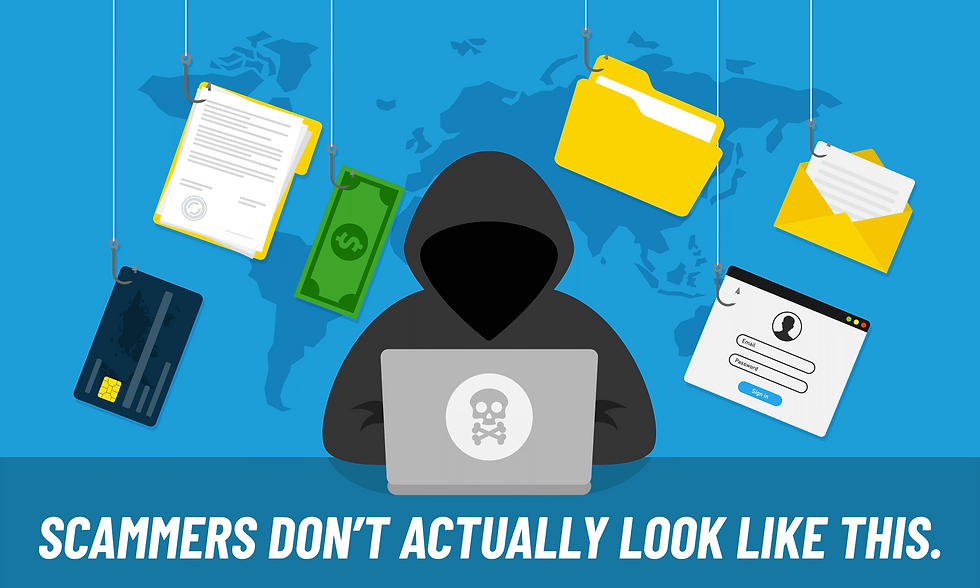Could You Spot a Scammer?

Scams got a big boost during the pandemic and we've been hearing about more folks (even very tech-savvy ones) getting caught up in these schemes.
You might think your friends, family, and older relatives would be too smart to fall for these fraudsters, but many people do. The more we can spread the word about these scams and how to avoid them, the better. Saving even one person from the financial and emotional chaos these schemes cost is worth the effort, in our opinion. Consider this article a primer on the most common scams we are seeing these days.
The goal of scams is to steal your money, steal your accounts, or steal your identity.
Phishing
Phishing emails and texts mimic legitimate communications to trick you into giving up account logins, credit card or bank details, or other sensitive data so scammers can use or sell them. They look so real!
What do they look like? Scammers send you an email or text message asking you to verify your account or payment info, track a package (very tempting if you think you are about to receive something), or unfreeze your account. Inside is a link to a (very convincing) fake website that steals your info.
Scammers might also send you a file attachment or document link to get you to click and install malware on your computer or phone. In this case, you may think you will "just look" and not give out any information but the damage is done as soon as you click.
Here’s how to avoid getting scammed:
Remember that legitimate institutions will never ask for sensitive information (like usernames, passwords, Social Security numbers, or bank details) by email or text message.
Be suspicious if a message contains odd phrasing, grammatical mistakes, or typos.
Check the “from” information carefully to make sure messages are from a legitimate domain name or number that is actually associated with the company (e.g. bankemail@yourbank.com and not bankemail@bank23abc.com). Not sure? Call the company’s public phone number and check.
Don't click on links or open attachments. If you recognize and trust the sender and you are expecting the message, it might be okay to click. It's always a good idea to verify with a phone call.
Here’s a phishing email in action. Can you identify the red flags?
(Answers in the P.S.)

How many did you see? Did you catch the fake number at the bottom? Sneaky!
Spoofing
Spoofing calls are another scam on the rise. Scammers “spoof” the info on your caller ID to make it look like they're calling from a legitimate organization.
What do they look like? Scammers may claim to be from your bank, the IRS, the Social Security Administration, or other organizations to trick you into sending money or giving up sensitive information.
They may claim you owe money or threaten you with the police if you don't take action right away.
In other cases, they will impersonate a financial institution, claim your account is locked, and attempt to gain your account credentials to “unlock” it.
They might even call about an unexpected refund or windfall that you can only receive right now by handing over your personal information.
How to avoid getting scammed:
Be suspicious of calls from the IRS, Social Security, or any financial institution. If you receive one, ask for a case or employee ID, hang up, and call them back on the official number on their website.
Never confirm information over the phone unless you have personally called the official number or are expecting a call.
Hang up immediately if the caller threatens you or pressures you to resolve an issue over the phone right now.
Want to report a scammer who targeted you?
Scams work by taking advantage of fear, greed, and the desire to do the right thing. If something seems “off” or “too good to be true,” trust your instincts. Don't take the bait.
Never be afraid to contact a company through its official phone number or website to ask for clarification about a message or call. Better safe than sorry.
P.S. How many red flags did you spot in the phishing email?
The sender info shows the email did not come from Netflix's domain.
The email client (Gmail, in this case) flagged this email as suspicious.
No salutation. Typically, an official email will include some portion of your name.
Weird syntax.
That's not an official Netflix phone number.










Comments